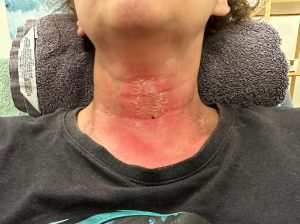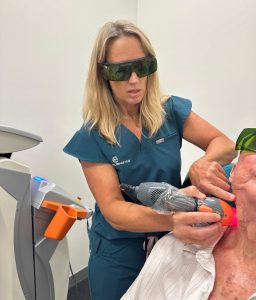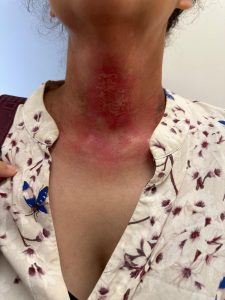Local leading expert in Head and Neck Lymphoedema
Cancer Rehabilitation & Lymphatic Solutions, located in Erina, are local leaders of Head and Neck cancer rehabilitation on the Central Coast. Led by Kate Perkins, a qualified Head and Neck Lymphoedema specialist OT, our dedicated team offers a comprehensive range of services to address the unique challenges and side effects faced by your patients undergoing or recovering from head and neck cancer (HNC) treatment.
Kate Perkins has built an impressive career specialising in this area. She takes a comprehensive approach to helping patients recover from head and neck cancer and its treatments, including managing the debilitating effects of radiation fibrosis and lymphoedema.
Kate addresses both the physical and emotional needs of her patients. “My role also goes beyond just the clinical aspects,” she explains. “I am the extra level of support for patients as they undergo treatments. Having someone to listen and provide informed recommendations can make a big difference.”
Read more in our blog article HEAD AND NECK CANCER REHABILITATION: RESTORING FUNCTION AND QUALITY OF LIFE
Global speaker and educator
This August, Kate Perkins is set to present a clinical paper at the World Association of Photobiomodulation Therapy’s (WALT) 30th Anniversary at PBM2024 Conference in London, on treating the side effects of radiation fibrosis in head and neck cancer patients using MLS® Laser.
Kate prides herself on staying at the forefront of cancer rehabilitation practices. She continually engages in professional development to keep abreast of emerging research, new techniques, and the latest evidence-based approaches. As a highly sought-after international speaker and educator, Kate regularly presents to oncology specialists, GPs, and other allied health professionals.
Her commitment to ongoing education ensures that your patients receive the most up-to-date and effective care.
Pioneering Treatment Approach in treating Head and Neck Cancer (HNC) side effects
Kate Perkins, co-founder with Dr Catherine Norton, of OncoLaser™ is leading the way in treating the side effects of head and neck cancer treatments using MLS® Laser in combination with hands-on techniques that can improve the quality of life for your patients.
Benefits for your patients
Pain management and reduction of treatment-related side effects: Rehabilitation techniques help manage radiation fibrosis, oral mucositis, dry mouth, trismus (reduced jaw function), and lymphoedema. State-of-the-art technologies like MLS® Laser Therapy, combined with specialised hands-on techniques, are employed to alleviate these side effects.
Regaining strength, endurance, and mobility: Targeted exercises and therapies help patients regain their physical capabilities, improving strength, endurance, and mobility.
Lymphoedema management: Manual lymphatic drainage, compression garments, and specific exercises are used to manage lymphoedema, reduce radiation fibrosis, and improve lymphatic function.
Psychological support: In collaboration with psychologists and support groups, rehabilitation provides emotional support to cope with anxiety, depression, and adjustments to changes in appearance and social roles.
OncoLaser™: A Comprehensive Solution to Reduce Radiation Fibrosis, Increase Lymphatic Drainage Function and Minimise Development of Acute Side Effects
At Cancer Rehabilitation & Lymphatic Solutions, we employ the cutting-edge OncoLaser™ treatment using MLS® Laser and hands-on techniques to reduce and delay the formation of radiation fibrosis. Photobiomodulation therapy (PBMT) using MLS® Laser Therapy has been shown to have several biological effects, including:
· Reducing cytokine production, an excessive inflammatory response, leading to the deposit of excessive amounts of collagen and other matrix proteins, which leads to tissue stiffening and scarring.
· Reducing thicker scar tissue formation in the area of radiation treatment, allowing for unimpeded lymphatic function and reduced lymphoedema symptoms (swelling)
· Vasodilation of blood vessels to surgical sites to facilitate optimal healing
· Intra-oral MLS® Laser treatment to reduce oral mucositis by stimulating salivary glands, and reduce internal swelling
Assisting your patients with Radiation Fibrosis
One of the significant concerns in head and neck cancer treatment is the formation of radiation fibrosis. This condition develops as a result of exposure to therapeutic radiation, which can damage DNA and cells in the targeted area. The body’s attempt to repair the affected tissues triggers excessive inflammatory response, leading to the deposit of excessive amounts of collagen and other matrix proteins, leading to tissue stiffening and scarring.
As collagen accumulates, it can cause the affected tissues to become thickened and fibrotic, resulting in the development of scar tissue. This fibrosis can lead to various symptoms, including excess radiation fibrosis, lymphoedema (swelling) in the face, neck, and intra-orally, reduced neck and shoulder movement and strength, and extreme fatigue.
Clinically proven results
Kate Perkins and her team at Cancer Rehabilitation & Lymphatic Solutions are passionate advocates of delivering the most optimal, evidence- based outcomes for your patients. The team are currently involved in active real world in-clinic research for their patients which involve measuring the quality of life (QoL) and quantifies the self reporting of treatment outcomes. Objective baseline and outcome measurements are also included in the ongoing data collection, collated by a dedicated team.
Utilising the latest technology and equipment
Kate Perkins and her team are forerunners in innovation and are early adopters of LymphaTech, a new best practice to enable frequent, accurate measurement of limb volume & circumference to enhance patient care. LymphaTech offers the only validated standardised digital measuring solution. Kate and her team are one of the first to utilise this highly advantageous software.
Patient cases and results
Case – HNC
Case Report – Vanessa 39 years old
Early Intervention – OncoLaser® photobiomodulation therapy (PBMT) during and after radiation therapy
Diagnosis: Multifocal larynx SCC with subglottic deposit (high risk cT1N0)
Treatment area: Whole larynx and bilateral neck nodes (prophylactic)
Radiation Dose: 68Gy/34fractions, given 6 fractions per week (accelerated) delivered by radiation oncologist
Acute Side effects:
· Reduced voice projection
· Persistent cough with phlegm – coughing lead to multiple rib fractures
· Erythema anterior neck
· Fatigue
· Muscle tightness neck and shoulders

After RT
5 days post RT
34 days post RT
Vanessa presented to the clinic, referred by her radiation oncologist, for early intervention of OncoLaser® photobiomodulation therapy (PBMT) delivered by state of the art technology, MLS Laser. PBMT delivered by MLS Laser, is completely non-invasive, pain free, and achieves multiple biological effects simultaneously.
The treatment delivered during radiation treatment, twice weekly, consisted of intra-oral PBMT, using a specific intra-oral diode. The treatment delivered aimed at reducing the severity and developmental of oral mucositis (OM), dry mouth, and loss of taste.
External delivery of OncoLaser® PBMT during radiation therapy was focused on maintaining muscle tissue softness of the neck and shoulders, to maintain optimal neck and shoulder range of movement.
Vanessa developed significant coughing symptoms during the radiation treatment, leading to inflammation and subsequent rib fractures. PBMT delivered via the hands-free robotic laser diode, treating the ribcage area to reduce inflammation and facilitate faster tissue healing.
On the immediate completion of radiation therapy, the hands-free robotic arm of the MLS Laser delivered treatment to the area of radiation on the anterior neck to reduce superficial inflammation of the tissue, and commence the tissue healing process of damaged tissue from radiation. The aim of early treatment with MSL Laser is to reduce the development of radiation fibrosis and reduce the risk of developing lymphoedema symptoms.
Current reported symptoms as at 20/04/2024
· Nil oral mucositis
· Mild dry mouth around the lips – most likely secondary side effect to medication
· Healed skin/tissue over radiation treatment area
· Nil oedema
· Increased neck and shoulder range of movement (ROM)
· Gradual return to work as energy levels increase
· Minimal pain symptoms in the right side fractured ribs
Due to the radiation treatment directed to the larynx, Vanessa has intermittent reduce voice projection capacity, which is gradually improving.
Vanessa is actively recording treatment outcomes, quality of life scoring, and quantitative scoring of radiation therapy side effects and the effectiveness OncoLaser® treatments, in CRLS’s real world research. Vanessa is able to complete a monthly patient survey via an app, to contribute to the ongoing real-time, real world data collection to measure the outcomes of treatment.
When should you start your patients on rehab treatment?
The sooner the better!
Based on clinical evidence, it is safe to receive intra-oral and external MLS Laser treatment to minimise the development of oral mucositis, dry mouth and loss of taste.
Early treatment using MLS Laser delays the development of radiation fibrosis, maintaining tissue softness, and reduces the risk of developing chronic side effects of treatment for HNC.
Kate and the team work closely with health care professionals are able to collaborate with you to ensure best outcomes for your patient.




